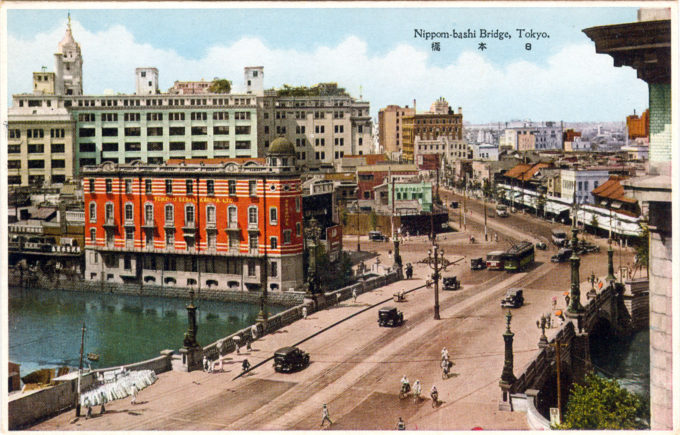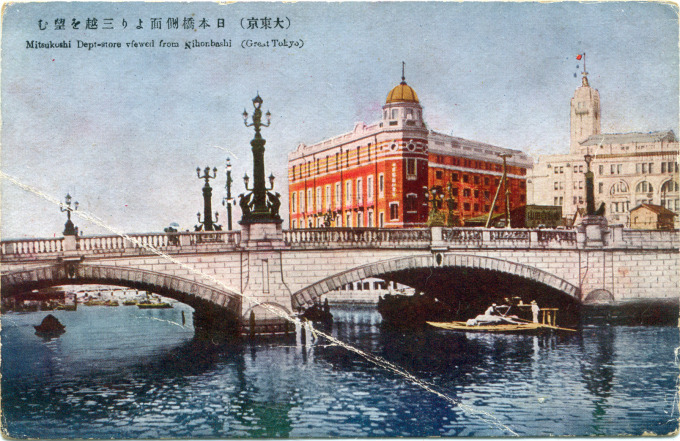“The Imperial Hemp Weaving Company building, designed by Tatsuno Kingo and erected in 1911, was closely associated with the [Nihonbashi] waterside environment.
“Facing the bridge was a tower-like stairwell, which served as an exterior accent. From the windows at the top of the spiral staircase could be seen the imposing outline of Nihonbashi Bridge and, slightly further down, the surface of the river.”
– Tokyo, a Spatial Anthropology, by Hidenobu Jinnai, 1995

The red-brick Imperial Hemp Weaving Co. Building [Teikoku Seimai Kaisha], designed by Tatsuno Kingo, astride Nihonbashi Bridge, c. 1930. Behind it is Mitsukoshi department store. The Imperial Hemp Weaving Co. was incorporated in 1907, the result of the merging of four companies that manufactured linens and hemp products.
“The Teikoku Seima Kaisha, Ltd. (Imperial Hemp Manufacturing Co. ) is situated at Uragashi, Nihonbashi-ku, Tokyo, and was established in 1885.
“[Even though] hemp is one of the oldest products of this country … no factory with modern machines was in existence before the Omi Hemp Thread Spinning Co., Ltd. was established in 1885, in the province of Omi. Equipped with machines purchased from France, the factory was put in operation in the following year. This is the origin of the present Teikoku Seima Kaisha.
“In 1887 there came into existence the Hokkaido Seima Kaisha, which made every effort for the development of the cultivation of flax in the Hokkaido. It is largely due to the efforts of this company that flax is now one of the staple products of the Hokkaido. In the same year another hemp manufacturing company was established in the province of Shimotsuke, under the style of the Shimotsuke Seima Kaisha.
“In 1896 still another hemp manufacturing company was started in Osaka under the name of the Osaka Seima Kaisha. In 1904, the three companies of the Omi, Shimotsuke and Osaka formed themselves into the Nihon Seima Kabushiki Kaisha.
“In 1907, this company and the Hokkaido Seima Kaisha were combined, with the result that there came into being the Teikoku Seima Kabushiki Kaisha.
“Having thus practically monopolized the market, the company exerted its efforts for the improvement of the qualities of the articles, and now enjoys an excellent reputation both at home and abroad.”
– Japan in the Taisho Era: In Commemoration of the Enthronement, 1917

Nihonbashi Bridge (foreground), the Imperial Hemp building, and Mitsukoshi department store (right), c. 1930.
“Tatsuno Kingo studied architecture at the Imperial College of Engineering where he was a student of the influential British architect Josiah Conder. After his graduation in 1879, Tatsuno journeyed to London in 1880 attending courses at the University of London. On his return to Tokyo, Tatsuno taught first at the Imperial College of Engineering before becoming department head at University of Tokyo.
“In 1886, Tatsuno was one of the founders of the forerunner of the Architectural Institute of Japan, the then-named ‘Building Institute’. The organization was based upon the Royal Institute of British Architects. The group met regularly, sponsored lectures, and produced Japan’s first architectural journal.
“Among the significant buildings Tatsuno designed in Tokyo are included Tokyo Central Station, the Bank of Japan, Manseibashi Station, and the original Kokugikan [National Sumo Hall]; and in Nara, the Nara Hotel.”
– Wikipedia

